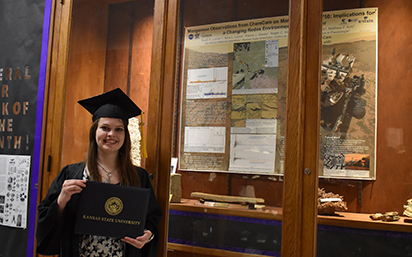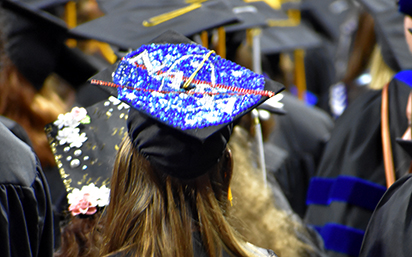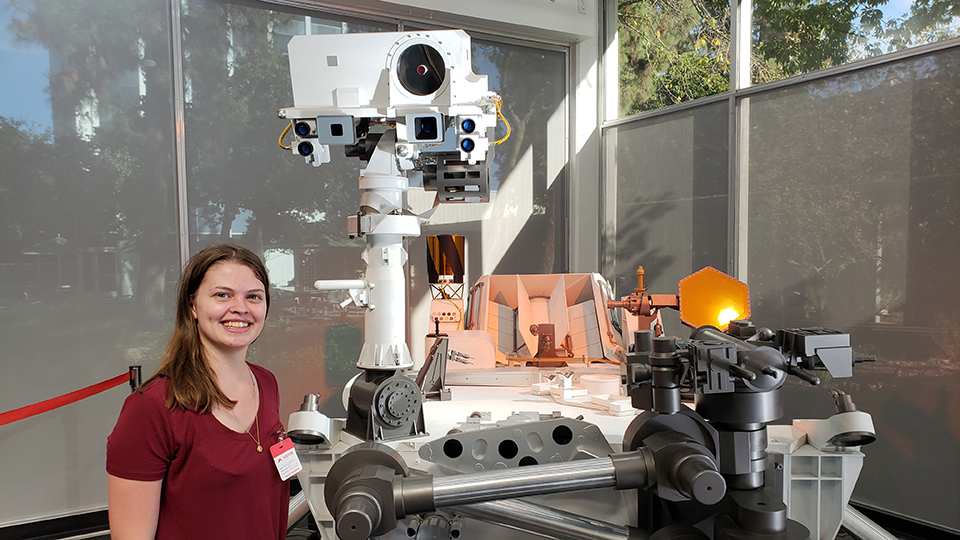K-Stater reaches for the stars and fulfills dream of working for NASA
Since she was a sophomore in high school, Sarah Lamm ’18 knew that she wanted to someday
work for NASA.
During her first year at Kansas State University, she was already applying for internships
at the space exploration agency. Her K-State graduation cap was even decorated with
the NASA logo in rhinestones.
That passion for space exploration and discovery has paid off — as a Northern Arizona
University doctoral student, she is a member of NASA’s Curiosity mission team, helping
search for signs of life on Mars.
NAU has a lab where students and professors can direct Curiosity — a car-sized rover
— around the surface of Mars. Lamm is involved with the rover’s ChemCam: an infrared
laser and camera that serves as Curiosity’s “head” and “eyes.”
According to NAU, Lamm’s research includes looking at pictures of rocks shot with
lasers and analyzing their chemical composition. The end goal is to determine whether
life could have existed on Mars by examining if the necessary conditions were ever
present for life to survive.
Although the surface of Mars is a long way from Manhattan, Kansas, Lamm thanks K-State for giving her the tools she needed
to reach her dream.
“K-State prepared me to think critically, to be bold, and to search for opportunities,”
she said. “If there was not an opportunity, then I needed to create one myself.”
From K-State to NASA
 Lamm said that when she was originally looking at colleges, she narrowed it down to
either K-State or KU. After visiting the two schools and meeting with faculty members,
she decided on K-State.
Lamm said that when she was originally looking at colleges, she narrowed it down to
either K-State or KU. After visiting the two schools and meeting with faculty members,
she decided on K-State.
During her junior and senior years of high school, she also was a full-time community
college student and graduated with an associate of science in engineering and an associate
of arts in political science the same weekend as her high school graduation. She arrived
at K-State as a junior with approximately 70 credits. Since it was going to be hard
for her to be a full-time student with so many pre-existing credits and only one major,
she decided on not two but three different majors: chemistry, geology and geography.
She knew an internship during her time at K-State could help open the door for her
to work at NASA. However, one internship she was interested in required a letter of
recommendation from a geology professor, and at that time, Lamm had only taken one
geology course at K-State — so it would have to be that professor writing the letter.
That professor was Matthew Kirk, a geomicrobiologist in the Department of Geology.
He agreed to send a letter of recommendation, and he also mentioned he had a colleague
who worked on the Curiosity rover. He offered to send Lamm’s resume to Nina Lanza
at Los Alamos National Laboratory, who was on the ChemCam team. She was impressed
by Kirk’s recommendation and Lamm’s resume.
Lamm was eventually offered an internship for the summer of 2016, and Lanza has been
her mentor ever since.
“None of the departments I was in had a focus in planetary science — but I didn’t
let that stop me from trying,” Lamm said. “I got my LANL internship by being bold
and asking a professor I barely knew at the time for a letter of recommendation.”
From NASA to Mars
 Lamm said one of her favorite parts of working with Curiosity is being involved with
operations.
Lamm said one of her favorite parts of working with Curiosity is being involved with
operations.
“I am fully trained to be the ChemCam science downlink lead,” she said. “Which means
I download the latest data and make preliminary reports. I love this because I might
be one of first people in the world seeing this data, and it’s my responsibility to
alert the team to anything unusual I see.”
So, how does the ChemCam work, exactly?
“The laser shoots rocks, vaporizing them into plasma that gives off light collected
by spectrometers on Curiosity,” NAU says. “The light gives off different wavelengths
that correspond to different elements, and scientists back on Earth compare them with
samples of known elemental concentrations. The process allows the team to approximate
the chemical composition of rocks on Mars.”
She also signed up for the CURIOSITY MISSION UPDATE.
“Scientists who have volunteered get to write about what Curiosity is doing that day,”
she said. “I usually blog on days that I am the ChemCam science downlink lead.”
In the future, Lamm hopes to end up at a NASA facility or at Los Alamos National Laboratory.
Her goal is to be a principal investigator on an instrument going to Titan, the largest
moon of Saturn.
Wherever her career takes her, she plans to continue exploring boldy.
“Space exploration is exciting because of the challenges of sending spacecrafts and
rovers,” Lamm said. “There is so much that goes into planning and designing these
missions. Every new analysis from Curiosity is completely new data.”
READ MORE about Lamm’s work with NASA.

